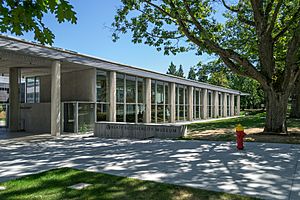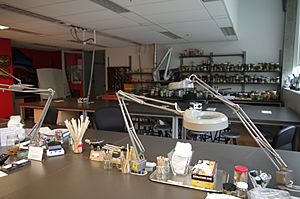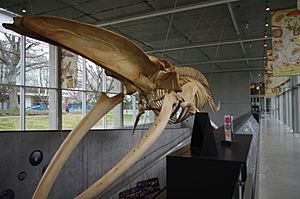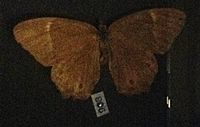Beaty Biodiversity Museum facts for kids
 |
|
| Lua error in Module:Location_map at line 420: attempt to index field 'wikibase' (a nil value). | |
| Established | 2010 |
|---|---|
| Location | 2212 Main Mall, University of British Columbia, Vancouver, British Columbia, Canada |
| Type | Natural History Museum |
| Visitors | 42,367 (2017–18) |
The Beaty Biodiversity Museum is a cool natural history museum located in Vancouver, British Columbia, Canada. It's part of the University of British Columbia (UBC). The museum first opened its doors on October 16, 2010. It has a huge space, about 20,000 square feet, filled with amazing collections and exhibits. Since opening, over 35,000 people visit the museum every year!
The museum is home to more than two million specimens. These were collected over many years, starting from the 1910s. The collections include different groups like the Cowan Tetrapod Collection, the Marine Invertebrate Collection, and the Fossil Collection. There's also the Herbarium, the Spencer Entomological Collection, and the Fish Collection. The museum especially focuses on animals and plants found in British Columbia, Yukon, and along the Pacific Coast. The most famous display is a giant 25-meter (about 82-foot) skeleton of a female blue whale. It hangs high above the main entrance, welcoming visitors.
Contents
Where is the Museum?
The Beaty Biodiversity Museum is located at the University of British Columbia (UBC) in Vancouver. You can find it at 2212 Main Mall, Point Grey. Right next to the museum is the UBC Fisheries Centre. This center has its own cool display of skeletons. You can see a minke whale, a killer whale, two Steller sea lions, and three Pacific white-sided dolphins there.
The Museum Building
The museum is inside a large, four-story building. It was designed by Patkau Architects in 2009. The building is about 11,520 square meters (124,000 square feet) in size. It was built to complete a beautiful outdoor area on the campus.
The museum has a theater and a large exhibit area. When you enter, you walk into the Mowafaghian Atrium. This is a tall, glass-walled space. Here you'll find the museum's gift shop and a cafe. Most importantly, this is where Canada's largest blue whale skeleton hangs! The whale is suspended over a ramp that leads down to the main collections. There's also a "family zone" with books for younger visitors. A "Discovery Lab" offers hands-on learning. Many collections are shown in display cases. Some are even in "excavations" under glass floors that you can walk on!
The building cost $50 million to build. It was designed to be very eco-friendly. It has a green roof and a special water garden. These help reduce pollution and manage rainwater. The building mostly uses natural ventilation instead of air conditioning. This keeps it cool and saves energy. Natural light is also used a lot. This helps save electricity and protects sensitive collections. The museum also has many "recycling hubs" and places for composting organic waste.
Museum History
The different collections at the Beaty Biodiversity Museum are actually much older than the museum itself. Some parts date back to the early 1900s! Before the museum was built, these collections were kept in separate places all over the UBC campus. The idea for one big museum to hold them all came up in 2001. University professors wanted a place where scientists could work together on biodiversity. They also wanted a public museum to share these amazing collections.
The museum is named after Ross and Trisha Beaty. They are UBC graduates who gave $8 million to help create it. Other groups also helped fund the museum. The first director was Dr. Wayne Maddison. The current director is Dr. Quentin Cronk, who started in 2020.
What's in the Collection?
The museum holds over two million specimens. Some of these are from as far back as the 1910s. These specimens are organized into six main groups. These are the Cowan Tetrapod Collection, the Marine Invertebrate Collection, and the Herbarium. Also included are the Spencer Entomological Collection, the Fish Collection, and the Fossil Collection. There are over 500 permanent exhibits to explore. Most items have a small card next to them. This card tells you what the specimen is and where it came from.
Blue Whale Exhibit
The museum's most famous display is its 25-meter (82-foot) long skeleton of a female blue whale. This huge skeleton is in the museum's glass atrium. It is Canada's largest blue whale skeleton. It's also one of only 21 blue whale skeletons on public display around the world. What's even cooler is that it's the largest skeleton exhibit in the world that hangs without any outside support!
The story of how the whale was found, moved, and put on display was shown in a Discovery Channel documentary. It was called Raising Big Blue. This movie is often shown at the museum's theater.
Cowan Tetrapod Collection
The Cowan Tetrapod Collection started in 1951. It's named after its first curator, Dr. Ian McTaggart-Cowan. "Tetrapod" means animals with four limbs, like mammals, birds, reptiles, and amphibians. This collection brought together several older collections.
This collection has over 40,000 items. These represent more than 2,000 different species of vertebrates. It includes 18,000 mammals, 17,500 birds, and 7,000 bird eggs. There are also 1,600 reptiles and amphibians. It's the second largest collection of these animals in British Columbia.
The museum has many examples of almost all species found in British Columbia. This includes land animals and marine mammals. Some specimens are very old, from as far back as 1849. You can also see rare animals like the red panda. There are even specimens of extinct species, like the passenger pigeon.
Marine Invertebrate Collection
The Marine Invertebrate Collection began in the 1930s. It started with specimens preserved in alcohol. These were collected by Dr. C. McLean Fraser and Dr. Ian McTaggart Cowan. The collection was first used for teaching. Over time, it grew to thousands of specimens. These include many different types of invertebrate animals. Invertebrates are animals without backbones, like jellyfish, snails, worms, starfish, and crabs.
The collection grew a lot in 2006 with a donation of shells and corals. Another large donation came in 2007. The items in this collection show the main groups of animals without backbones. This includes jellyfish, molluscs (like snails and clams), worms, starfish, crabs, and sponges.
Herbarium
The Herbarium is one of the oldest collections at UBC. It was started in 1912 by John Davidson. He was the BC provincial botanist at the time. His collection of mostly vascular plants (plants with roots, stems, and leaves) was first in downtown Vancouver. It moved to the university campus in 1925. A separate seed collection also grew from donations. An algae collection started before 1952. It grew very quickly under Robert Scagel. The Bryological Collection (mosses and liverworts) began in 1949. All these different collections were brought together into the Herbarium in 1973. Then, they moved into the Beaty Biodiversity Museum when it was finished.
The Herbarium has over 650,000 specimens. It is the largest herbarium (a collection of preserved plants) in Canada west of Ottawa. Researchers use these specimens to identify plants and discover new species. They also help track how plant diversity changes over time. The collection includes land plants like conifers, ferns, mosses, and flowering plants. It also has algae, lichens, and fungi. The collection is especially strong in plants from British Columbia. It also has many Pacific algae, fungi, Hawaiian plants, and tropical prayer plants. Its algae collection is the most complete of any Herbarium. The bryophyte collection is the largest in Canada. The fungi collection is the largest research collection of large fungi from British Columbia. The lichen collection is one of the biggest in western North America.
Spencer Entomological Collection
The Spencer Entomological Collection was started by Dr. George Spencer in the 1920s. It includes insect specimens from as early as the 1830s. When it began, it wasn't an official university collection. But by the time Dr. Spencer retired, it had over 300,000 items! It became an official university collection in 1953. Dr. G.G.E. Scudder took over in 1958. He doubled the size of the collection during his 40 years in charge.
Now, this collection has over 600,000 items. This includes more than 500,000 pinned insects, 25,000 on slides, and 75,000 in alcohol. It is the second-largest insect collection in Canada. It focuses on insects from British Columbia and Yukon. The collection is especially strong in true bugs, dragonflies, damselflies, fleas, and lice. Besides specimens, it also has 350 books and other materials about insects.
Fish Collection
Dr. C. MacLean Fraser, the first head of UBC's Zoology Department, gave her collections to the university in the 1940s. These were shown in a UBC Fish Museum. The UBC Institute of Fisheries was founded in 1952. This led to a fast growth of the collections. New specimens were added from expeditions and exchanges with other institutions. The collection moved to the biology department in 1960. Later, it moved to the Beaty Biodiversity Museum with the Herbarium.
The Fish Collection has over 850,000 specimens. These include whole fish preserved in alcohol, skeletons, and fish X-rays. It also has over 50,000 DNA and tissue samples. It is the third largest fish collection in Canada. It is especially strong in freshwater and nearshore marine species. The collection includes fish from Canada, the Aleutians, Mexico, the Galapagos Islands, and the Amazon River Basin.
This collection has been used to help with conservation efforts. It also helps with environmental studies and many research projects. It has also helped train some of Canada's top fish biologists.
Over 2,300 species from the Fish Collection are listed in FishBase. This is a global fish relational database that helps researchers around the world. The museum's collection was the first to be added to FishBase.
Fossil Collection
Dr. Merton Yarwood Williams, who helped start the UBC Geology Department, began the Fossil Collection in 1924. He got the first items from mining engineer William John Sutton. The collection was shown in the Geological Sciences Centre starting in 1971. However, the exhibit closed in 1995 due to money problems. The collection became part of the Pacific Museum of the Earth in 2003. It is currently housed at the Beaty Biodiversity Museum while it is being re-catalogued.
The Fossil Collection has over 20,000 items. Some cool highlights include its stromatolites. These are rock formations made by blue-green algae. They are about 500 million years old, making them some of the oldest fossils! The collection also has examples from the famous Burgess Shale.
In 2018, the museum added three casts of dinosaur trackways to its permanent exhibits. These came from the Peace Region area of British Columbia.
See also
 In Spanish: Museo de Biodiversidad Beaty para niños
In Spanish: Museo de Biodiversidad Beaty para niños








